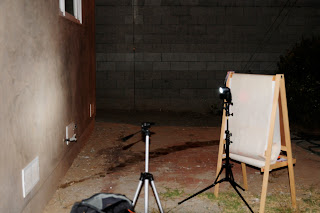(Sorry for the infrequent posting this week -- my limited time allocated for photography was spent debating on a photo-related forum.)
If you bounce your flash, you know that it requires a lot of power. First, most bouncing surfaces aren't perfect reflectors. Second, the light has to travel from the flash to the bouncing surface and then back to the subject.
To squeeze the most light out of our little speedlight, we can zoom the flash. Zooming the flash doesn't increase the total amount of power that the speedlight produces. However, it concentrates the light beam into a smaller coverage area. Light that would otherwise be spread out into a wider area now occupies a smaller area, thus increasing light intensity. The drawback is that with a smaller coverage area, the light becomes harder, but it should still be quite soft.
To illustrate the difference that zooming makes (both in terms of intensity as well as quality of light, i.e., softness) check out these test shots. I set up a flash (SB-800) on a light stand to bounce against a wall (note: our wall is a brownish color but is a smooth surface). Immediately behind the flash is an easel with white paper, which acts as the subject. I placed a camera (Nikon D300) on a tripod to take a photo of the white paper. The D300's popup flash triggered the SB-800 with Nikon CLS AWL (Advanced Wireless Lighting), and the flash was set on manual mode (1/4 power). The light from the flash bounces from the wall and illuminates the paper. We can therefore determine how much light falls on the subject based on the brightness of the paper. From the shadow cast by the flash, we can also observe any change in the quality of the light (softness). Here is a picture of the set up shot:
To avoid skewing the results, the popup flash was set to inactive ("--") and covered with an SG-3IR infrared panel. I also minimized the effect of ambient by shooting at night, at the sync speed (1/250) and using the base ISO (200 for the D300). I shot on manual exposure with active d-lighting off, auto ISO set to off, etc.
Here is a baseline shot with the flash set to 24mm. Exposure: ISO 200, 1/250, f/5.6. Quite soft -- despite the flash being only a few inches from the paper, the shadow is barely noticeable.
Here is a comparison shot with the flash set to 105mm. Exposure: ISO 200, 1/250, f/5.6. Note that the paper appears brighter compared to the shot at 24mm. At the same time, the shadow is more defined, which means the light is harder, but it's still quite soft.
I don't have a flashmeter to measure the difference in intensity, but it's about 1/3 stop. Here is a shot with the flash at 105mm at ISO 200, 1/250, f/6.3 (note that the paper is almost the same brightness as the 24mm flash shot at f/5.6).
Not a huge difference, but then again, neither has the light become that much harder. If I need the extra power, I wouldn't hesitate to trade the extra hardness for the extra light by zooming the flash.




No comments:
Post a Comment
Thanks for your comment. It will be published as soon as we get a chance to review it, sorry for that, but we get lots of spam with malicious links.